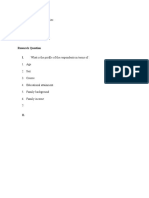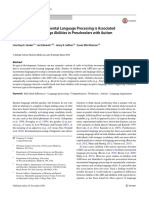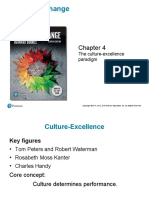Snowling
Snowling
Uploaded by
jorgedacunhaCopyright:
Available Formats
Snowling
Snowling
Uploaded by
jorgedacunhaOriginal Description:
Copyright
Available Formats
Share this document
Did you find this document useful?
Is this content inappropriate?
Copyright:
Available Formats
Snowling
Snowling
Uploaded by
jorgedacunhaCopyright:
Available Formats
Journal of Child Psychology and Psychiatry **:* (2009), pp ****
doi:10.1111/j.1469-7610.2009.02197.x
Editorial: Virtual Issue Changing concepts of dyslexia: nature, treatment and comorbidity
This topic for this the rst Virtual Issue of JCPP was prompted by a recent independent review, Identifying and teaching children and young people with dyslexia and literacy difculties (Rose, 2009). This review drew on a large evidence-base and took as its working denition that dyslexia is a disorder primarily affecting reading and spelling development, usually associated with impairments of phonological processing, verbal processing speed and verbal short-term memory. It also acknowledged that dyslexia is often accompanied by other features that affect educational attainment (comorbidities), though these are not themselves characteristics of dyslexia. The papers selected for this Virtual Issue have been chosen to reect the evolution of this view of dyslexia, which can be traced from the landmark Isle of Wight study differentiating specic from general reading difculties, reported in the journal in 1975 by Rutter and Yule, through the now classic argument of Stanovich (1994) that questioned the utility of the discrepancy denition of dyslexia, to the contemporary view of dyslexia as a phonological decit (Vellutino, Fletcher, Snowling, & Scanlon, 2004). Against this backdrop, a set of papers is presented, each of which highlights that dyslexia is not a disorder with clear-cut boundaries or with a single cause. Three papers in the selection address the overlap between reading and language impairment: McArthur, Hogben, Edwards, Heath, and Mengler (2000) report that some 55% of children with specic reading disability (SRD) have oral language difculties while 51% of children with specic language impairment (SLI) have SRD. However, the risk of SRD depends upon the nature of the language impairment: Raitano, Pennington, Tunick, Boada, and Shriberg (2004) showed that the pre-literacy outcomes of children with pre-school speech impairment (speech sound disorder; SSD) were relatively good unless their speech difculties were persistent or they had broader language difculties. The nding of a relatively low risk of reading impairment in children with a history of pure speech impairment is reminiscent of earlier work by Bishop and Adams reported in the journal in 1990, which also showed that specic difculties with reading comprehension were more common among children with SLI than the pervasive decits in word-level decoding characteristic of dyslexia. What of children learning to read in languages other than English? It might be supposed that the risk of dyslexia would be less in languages that have more transparent writing systems with fewer irregularities, or in which there are fewer phonological demands because mappings are not at the level of the phoneme (as in alphabetic systems) but involve large units such as syllables or morphemes (e.g., in Chinese). However, Puolakanaho et al. (2007) reported ndings from a study of children at family risk of dyslexia in the highly regular Finnish orthography, showing that 36% of at-risk children are classied as reading disabled at 8.09 years, a gure comparable to that for children learning to read in English. This study also showed that it was possible, with an acceptable degree of accuracy, to use a small set of measures to predict, as early as 3.5 years, who would develop reading problems. These were letter knowledge, rapid naming (a measure of phonological skill) and family-risk status. Extending the method of a family-risk prospective study to Cantonese, McBride-Chang et al. (2008) found that in the second year of kindergarten (45 years), children at family risk were already lagging behind their peers in learning to read Chinese characters and their difculties were associated with impairments in tone detection (a measure of phonological skill) and in morphological awareness. Language delayed children who also experienced reading difculties were characterised by a wider range of cognitive and linguistic impairments including these decits. The increased risk of reading difculties in children from at-risk families is suggestive of a genetic etiology, but since families share environments as well as genes, dyslexia could in principle be the outcome of environmental factors associated with low literacy. Stevenson and Fredman (1990) reported data from a twin study showing that 32% of the variance in reading was accounted for by IQ and social factors including mothers educational level, family size, housing and social circumstances and some aspects of emotional atmosphere at home. However, when IQ was controlled, only two environmental factors had a signicant effect on individual differences in reading; these were family size (a general environmental effect) and maternal criticism (a specic environmental effect that might actually be a consequence of a childs reading failure). This paper also makes clear that even in propitious circumstances and when literacy instruction is good, some children will still experience reading
2009 The Authors Journal compilation 2009 Association for Child and Adolescent Mental Health. Published by Blackwell Publishing, 9600 Garsington Road, Oxford OX4 2DQ, UK and 350 Main Street, Malden, MA 02148, USA
Editorial
difculties. Consistent with this, Kovas et al. (2007), using data from the Twins Early Development Study, showed that reading disability is moderately heritable; further, there was some 33% overlap between reading disability and mathematics disability. While much of this overlap was due to shared genetic factors (generalist genes), there were also genetic inuences specic to reading and specic to mathematics. Based on past research, a reasonable hypothesis is that the comorbidity of reading and mathematics disability is due to shared verbal decits (affecting the development of arithmetic competence) and, as intimated above, the comorbidity of dyslexia and SLI is likely due to shared phonological decits. As further papers in this issue illustrate, dyslexia also co-occurs with two quite distinct disorders, attention decit/hyperactivity disorder (ADHD) (Bental & Tirosh, 2007) and developmental coordination disorder (Rochelle & Talcott, 2006), and is associated with a range of other conditions affecting mental health (Carroll, Maughan, Goodman, & Meltzer, 2005). Given knowledge of the nature and characteristics of dyslexia, an ongoing challenge for practitioners who identify dyslexia is the implementation of intervention programmes. Recognising the comorbidity of dyslexia and ADHD, Gittelman and Feingold (1983) were amongst the rst to conduct an early controlled trial to evaluate the efcacy of an 18-week phonics intervention as a treatment for poor readers; in a companion paper in the same volume, they evaluated the impact of medication for ADHD on educational outcome. The ndings were intriguing; the phonics intervention was effective in promoting reading (but not spelling or arithmetic) whereas the medication (methylphenidate) had an impact on arithmetic but not on reading, hinting perhaps at the greater role of executive processes in arithmetic skill. More recently, Hatcher et al. (2006) showed that a 10-week intervention, combining training in oral phoneme awareness and structured book reading plus activities linking the two skills, could be delivered by trained teaching assistants to increase the reading skills of poor readers in Year 1. Extending this work to younger children who enter school with poor speech and language, Bowyer-Crane et al. (2008) showed that the intervention was effective in accelerating reading progress, compared with that of a treated control group who received oral language intervention. A further positive nding was that the oral language programme successfully boosted vocabulary and expressive grammar. The science of dyslexia is well advanced and theory can be used to guide the design of intervention approaches. The papers selected here illustrate the range of research methodologies that have been fruitful to the eld and convergent evidence now presents a strong rationale for considering dyslexia as the behavioural outcome of a number of different
developmental pathways, mediated by a phonological decit. Omissions from the issue include important ndings from longitudinal studies of epidemiological samples (e.g., Fergusson & Lynskey, 1997) and papers representing molecular genetic (Gayan et al., 2005) and neuroscientic (Eliez et al., 2000) approaches.
Margaret J. Snowling
References
* indicates papers cited above but not included in the Virtual Issue selection
Bental, B., & Tirosh, E. (2007). The relationship between attention, executive functions and reading domain abilities in attention decit hyperactivitiy disorder and reading disorder: A comparative study. Journal of Child Psychology and Psychiatry, 48, 455 463. http://www3.interscience.wiley.com/journal/ 117960555/abstract Bishop, D.V.M., & Adams, C. (1990). A prospective study of the relationship between specic language impairment, phonological disorders and reading retardation. Journal of Child Psychology and Psychiatry, 31, 10271050. http://www3.interscience. wiley.com/journal/119367963/abstract Bowyer-Crane, C., Snowling, M.J., Duff, F.J., Fieldsend, E., Carroll, J.M., Miles, J., Gotz, K., & Hulme, C. (2008). Improving early language and literacy skills: Differential effects on an oral language versus a phonology with reading intervention. Journal of Child Psychology and Psychiatry, 49, 422432. http:// www3.interscience.wiley.com/journal/119392243/ abstract Carroll, J.M., Maughan, B., Goodman, R., & Meltzer, H. (2005). Literacy difculties and psychiatric disorders: Evidence for comorbidity. Journal of Child Psychology and Psychiatry, 46, 524532. http://www3. interscience.wiley.com/journal/118735409/abstract *Eliez, S., Rumsey, J.M., Giedd, J., Schmitt, J.E., Patwardhan, A.J., & Reiss, A.L. (2000). Morphological alteration of temporal lobe gray matter in dyslexia: An MRI study. Journal of Child Psychology and Psychiatry, 41, 637644. http://www3.interscience.wiley. com/journal/119004409/abstract *Fergusson, D.M., & Lynskey, M.T. (1997). Early reading difculties and later conduct problems. Journal of Child Psychology and Psychiatry, 38, 899 907. http://www3.interscience.wiley.com/journal/ 119143952/abstract *Gayan, J., Willcutt, E.G., Fisher, S.E., Francks, C., Cardon, L.R., Olson, R.K., Pennington, B.F., Smith, S.D., Monaco, A.D., & DeFries, J.C. (2005). Bivariate linkage scan for reading disability and attentiondecit/hyperactivity disorder localizes pleiotropic loci. Journal of Child Psychology and Psychiatry, 46, 10451056. http://www3.interscience.wiley.com/ journal/118735323/abstract Gittelman, R., & Feingold, I. (1983). Children with reading disorders I. Efcacy of reading remediation. Journal of Child Psychology and Psychiatry, 24, 167 191. http://www3.interscience.wiley.com/journal/ 119540746/abstract
2009 The Authors Journal compilation 2009 Association for Child and Adolescent Mental Health.
Editorial
Hatcher, P.J., Hulme, C., Miles, J.N.V., Carroll, J.M., Hatcher, J., Gibbs, S., Smith, G., Bowyer-Crane, C., & Snowling, M.J. (2006). Efcacy of small group reading intervention for beginning readers with reading-delay: A randomised control trial. Journal of Child Psychology and Psychiatry, 47, 820827. http://www3. interscience.wiley.com/journal/118727278/abstract Kovas, Y., Haworth, C.M.A., Harlaar, N., Petrill, S.A., Dale, P.S., & Plomin, R. (2007). Overlap and specicity of genetic and environmental inuences of mathematics and reading disability in 10-year-old twins. Journal of Child Psychology and Psychiatry, 48, 914 922. http://www3.interscience.wiley.com/journal/ 117960663/abstract McArthur, G.M., Hogben, J.H., Edwards, V.T., Heath, S.M., & Mengler, E.D. (2000). On the specics of specic reading disability and specic language impairment. Journal of Child Psychology and Psychiatry, 41, 869874. http://www3.interscience.wiley. com/journal/119004435/abstract McBride-Chang, C., Lam, F., Lam, C., Doo, S., Wong, S.W.L., & Chow, Y.Y.Y. (2008). Word recognition and cognitive proles of Chinese pre-school children at risk for dyslexia through language delay or familial history of dyslexia. Journal of Child Psychology and Psychiatry, 49, 211218. http://www3.interscience. wiley.com/journal/119392221/abstract Puolakanaho, A., Ahonen, T., Aro, M., Eklund, K., Leppanen, P.H.T., Poikkeus, A.-M., Tolvanen, A., Torppa, M., & Lyytinen, H. (2007). Very early phonological and language skills: Estimating individual risk of reading disability. Journal of Child Psychology and Psychiatry, 48, 923931. http://www3.interscience. wiley.com/journal/117960675/abstract
Raitano, N.A., Pennington, B.F., Tunick, R.A., Boada, R., & Shriberg, L.D. (2004). Pre-literacy skills of subgroups of children with speech sound disorders. Journal of Child Psychology and Psychiatry, 45, 821 835. http://www3.interscience.wiley.com/journal/ 118755382/abstract Rochelle, K.S.H., & Talcott, J.B. (2006). Impaired balance in developmental dyslexia? A meta-analysis of the contending evidence Journal of Child Psychology and Psychiatry, 47, 11591166. http://www3. interscience.wiley.com/journal/118727184/abstract *Rose, J. (2009). Identifying and teaching children and young people with dyslexia and literacy difculties. Available from http://publications.dcsf.gov.uk/ eOrderingDownload/00659-2009DOM-EN.pdf. Rutter, M., & Yule, W. (1975). The concept of specic reading retardation. Journal of Child Psychology and Psychiatry, 16, 181197. http://www3.interscience. wiley.com/journal/119651512/abstract Stanovich, K.E. (1994). Annotation: Does dyslexia exist? Journal of Child Psychology and Psychiatry, 35, 579595. http://www3.interscience.wiley.com/ journal/119266051/abstract Stevenson, J., & Fredman, G. (1990). The social environmental correlates of reading ability. Journal of Child Psychology and Psychiatry, 31, 681698. http:// www3.interscience.wiley.com/journal/119367927/ abstract Vellutino, F.R., Fletcher, J.M., Snowling, M.J., & Scanlon, D.M. (2004). Specic reading disability (dyslexia): What have we learned in the past four decades? Journal of Child Psychology and Psychiatry, 45, 240. http://www3.interscience.wiley.com/ journal/118755314/abstract
2009 The Authors Journal compilation 2009 Association for Child and Adolescent Mental Health.
You might also like
- Teach Reading with Orton-Gillingham: 72 Classroom-Ready Lessons to Help Struggling Readers and Students with Dyslexia Learn to Love ReadingFrom EverandTeach Reading with Orton-Gillingham: 72 Classroom-Ready Lessons to Help Struggling Readers and Students with Dyslexia Learn to Love ReadingRating: 5 out of 5 stars5/5 (1)
- Shaywitz 2008Document30 pagesShaywitz 2008jorgedacunhaNo ratings yet
- Boder 1973Document25 pagesBoder 1973jorgedacunha100% (1)
- The Multiple Deficit Model of Dyslexia What Does It Mean For Identification and InterventionDocument22 pagesThe Multiple Deficit Model of Dyslexia What Does It Mean For Identification and Interventioneebook123456No ratings yet
- Final Research Paper - VosDocument16 pagesFinal Research Paper - VosAnna VosNo ratings yet
- Vellutino Et Al, 2004 - Specific Reading Disability (Dyslexia) : What Have We Learned in The Past Four Decades?Document41 pagesVellutino Et Al, 2004 - Specific Reading Disability (Dyslexia) : What Have We Learned in The Past Four Decades?nubblerNo ratings yet
- Early Identification and Interventions For Dyslexia: A Contemporary ViewDocument9 pagesEarly Identification and Interventions For Dyslexia: A Contemporary Viewapi-313799104No ratings yet
- Down Syndrome 2Document19 pagesDown Syndrome 2Renelli Anne GonzagaNo ratings yet
- Dyslexia As A Phonological Deficit: Evidence and ImplicationsDocument8 pagesDyslexia As A Phonological Deficit: Evidence and ImplicationsAmeylia VanissaNo ratings yet
- PSYC0022 Dyslexia 2023Document41 pagesPSYC0022 Dyslexia 2023Yan Yiu Rachel ChanNo ratings yet
- DyslexiaDocument14 pagesDyslexiaRazelFernandezNo ratings yet
- Interventions For Childrens Language and Literacy DifficultiesDocument8 pagesInterventions For Childrens Language and Literacy DifficultiesFernanda Espinoza DelgadoNo ratings yet
- Oral Language Deficits in Familial Dyslexia: A Meta-Analysis and ReviewDocument48 pagesOral Language Deficits in Familial Dyslexia: A Meta-Analysis and ReviewnurlatifahNo ratings yet
- Wery y Diliberto, The Effect of A Specialized Dyslexia Font, OpenDyslexic, On Reading Rate and AccuracyDocument13 pagesWery y Diliberto, The Effect of A Specialized Dyslexia Font, OpenDyslexic, On Reading Rate and AccuracyMaria Florencia MartinezNo ratings yet
- Effects of Fluency, Oral Language and Ef On Reading Comprehension PerformanceDocument21 pagesEffects of Fluency, Oral Language and Ef On Reading Comprehension PerformanceCecilia AgostNo ratings yet
- 19 Parrila, Dudley, Song & Georgiou, Meta Analysis of Reading Level Match Dyslexia Studies in Consistent Alphabetic OrthographiesDocument27 pages19 Parrila, Dudley, Song & Georgiou, Meta Analysis of Reading Level Match Dyslexia Studies in Consistent Alphabetic Orthographiesjohanaruizc19No ratings yet
- LIDO - Mclntyre 2017 - Reading ProfilesDocument16 pagesLIDO - Mclntyre 2017 - Reading ProfilesDébora PiazarolloNo ratings yet
- Thesis Title: Spelling Abilities Thesis Statement: Statement of The Problem: Research Question IDocument7 pagesThesis Title: Spelling Abilities Thesis Statement: Statement of The Problem: Research Question IJ Espelita CaballedaNo ratings yet
- ED586106Document47 pagesED586106coqtwyigtibbepayxjNo ratings yet
- Reading DifficultiesDocument4 pagesReading DifficultiesHelenNo ratings yet
- King, Lemons, Davidson, Fulmer y Mrachko 2020Document18 pagesKing, Lemons, Davidson, Fulmer y Mrachko 2020Pedro Alberto Herrera LedesmaNo ratings yet
- Mam ManioDocument2 pagesMam ManioRUSLIE MARINOL CAOILENo ratings yet
- PSYC0022 Dyslexia 2022Document41 pagesPSYC0022 Dyslexia 2022Yan Yiu Rachel ChanNo ratings yet
- Hall2019 - Reading Instruction For English Learners With Learning DisabilitiesDocument45 pagesHall2019 - Reading Instruction For English Learners With Learning DisabilitiesErick SolisNo ratings yet
- Examining The Relations Between Reading Fluency and Reading Comprehension For English Language Learners PDFDocument15 pagesExamining The Relations Between Reading Fluency and Reading Comprehension For English Language Learners PDFVictor RubalcabaNo ratings yet
- Reading Achievement in Relation To Phonological Coding and Awareness in Deaf Readers: A Meta-AnalysisDocument25 pagesReading Achievement in Relation To Phonological Coding and Awareness in Deaf Readers: A Meta-AnalysisNino LomadzeNo ratings yet
- Burgoyne 2022 The Effect of Prompts On The SharedDocument28 pagesBurgoyne 2022 The Effect of Prompts On The SharedMirjana JeremicNo ratings yet
- Frijters Et Al (2011) Neurocognitive Predictors of DyslexiaDocument17 pagesFrijters Et Al (2011) Neurocognitive Predictors of Dyslexiadiana_carreiraNo ratings yet
- Dyslexia Research Paper TopicsDocument6 pagesDyslexia Research Paper Topicsaflbqewzh100% (1)
- Tayloret, 2021Document27 pagesTayloret, 2021NatalyRomeroGarateNo ratings yet
- Phonological and Phonemic AwarenessDocument11 pagesPhonological and Phonemic AwarenessMay Anne AlmarioNo ratings yet
- Thinking Ahead: Incremental Language Processing Is Associated With Receptive Language Abilities in Preschoolers With Autism Spectrum DisorderDocument13 pagesThinking Ahead: Incremental Language Processing Is Associated With Receptive Language Abilities in Preschoolers With Autism Spectrum DisorderTomas Torres BarberoNo ratings yet
- Dyslexia Research PaperDocument8 pagesDyslexia Research Paperscxofyplg100% (1)
- ANDY2010Document19 pagesANDY2010Tyco MacNo ratings yet
- 29.hayiou ThomasDocument12 pages29.hayiou ThomasErsya MuslihNo ratings yet
- Reading Comprehension Instruction For Students With Autism Spectrum DisordersDocument10 pagesReading Comprehension Instruction For Students With Autism Spectrum DisordersClaudia MihaiNo ratings yet
- Subtipos de Dislexia Vellutino y Fletcher en Developmental DyslexiaDocument6 pagesSubtipos de Dislexia Vellutino y Fletcher en Developmental DyslexiaAndy AramayoNo ratings yet
- Lyytinen Et Al MPQ 52 3 2006 Lehden OmaDocument34 pagesLyytinen Et Al MPQ 52 3 2006 Lehden OmaDavid TorresNo ratings yet
- Reading Ability in Children Relates To Rhythm Perception Across ModalitiesDocument27 pagesReading Ability in Children Relates To Rhythm Perception Across Modalitiesbiahonda15No ratings yet
- Performance of Children With Developmental Dyslexia On High and Low Topological Entropy Artificial Grammar Learning TaskDocument17 pagesPerformance of Children With Developmental Dyslexia On High and Low Topological Entropy Artificial Grammar Learning TaskPriss SaezNo ratings yet
- WolkandBrennan PhonoInvestigationAutism 2013Document9 pagesWolkandBrennan PhonoInvestigationAutism 2013ALEXANDRE BARBOSANo ratings yet
- Unidad 3 5Document18 pagesUnidad 3 5Trinni GuzmanNo ratings yet
- Developmental Outcomes For Children at High Risk of Dyslexia and Children With Developmental Language DisorderDocument17 pagesDevelopmental Outcomes For Children at High Risk of Dyslexia and Children With Developmental Language DisorderValeska CeciliaNo ratings yet
- Marks 2021Document23 pagesMarks 2021Centro AllkünNo ratings yet
- Dissertation On Reading DifficultiesDocument8 pagesDissertation On Reading DifficultiesSomeToWriteMyPaperFayetteville100% (1)
- Uso Del PECS en AutismoDocument22 pagesUso Del PECS en AutismoPsicoterapia InfantilNo ratings yet
- Longitudinal Impacts of Print-Focused Read-Alouds For Children With Language ImpairmentDocument14 pagesLongitudinal Impacts of Print-Focused Read-Alouds For Children With Language ImpairmentLuis.fernando. GarciaNo ratings yet
- Revised eDocument23 pagesRevised esidrence bajentingNo ratings yet
- 1 s2.0 B9780123747488000044 MainDocument32 pages1 s2.0 B9780123747488000044 MainAlex SamuelNo ratings yet
- 5 7. Dutta Et Al-2018-American Journal of Speech-Language PathologyDocument29 pages5 7. Dutta Et Al-2018-American Journal of Speech-Language PathologyDimas Ade MahendraNo ratings yet
- Precursorsof DyslexiaDocument26 pagesPrecursorsof DyslexiaiprintslNo ratings yet
- Malins 2020Document17 pagesMalins 2020NOR BIBI MASLINA BINTI JUSOH MoeNo ratings yet
- Hirsh-Pasek and Golinkoff 2012Document49 pagesHirsh-Pasek and Golinkoff 2012Francisco Javier Echenique ArosNo ratings yet
- Child Psychology Psychiatry - 2007 - Bental - The Relationship Between Attention Executive Functions and Reading DomainDocument9 pagesChild Psychology Psychiatry - 2007 - Bental - The Relationship Between Attention Executive Functions and Reading DomainCarolina AguiarNo ratings yet
- VellutinoDocument39 pagesVellutinojorgedacunhaNo ratings yet
- Developmental DyslexiaDocument11 pagesDevelopmental DyslexiaSamPSP4No ratings yet
- Araújo Et Al (2013) Phonological ProcessDocument16 pagesAraújo Et Al (2013) Phonological ProcessCarolinaNo ratings yet
- Do Working Memory Deficits Underlie Reading Problems in Attention-Deficit/Hyperactivity Disorder (ADHD) ?Document14 pagesDo Working Memory Deficits Underlie Reading Problems in Attention-Deficit/Hyperactivity Disorder (ADHD) ?Yannu JiménezNo ratings yet
- Brain & Language: Ellen Bialystok, Xiaojia FengDocument8 pagesBrain & Language: Ellen Bialystok, Xiaojia FenglucianaeuNo ratings yet
- Finding Beauty in The Ugly Facts About Reading ComprehensionDocument22 pagesFinding Beauty in The Ugly Facts About Reading ComprehensionHazel Mae Nepomuceno NodaloNo ratings yet
- Reading Interventions for the Improvement of the Reading Performances of Bilingual and Bi-Dialectal ChildrenFrom EverandReading Interventions for the Improvement of the Reading Performances of Bilingual and Bi-Dialectal ChildrenNo ratings yet
- School Success for Kids with Dyslexia and Other Reading DifficultiesFrom EverandSchool Success for Kids with Dyslexia and Other Reading DifficultiesRating: 3.5 out of 5 stars3.5/5 (9)
- VellutinoDocument39 pagesVellutinojorgedacunhaNo ratings yet
- TorgesenDocument8 pagesTorgesenjorgedacunhaNo ratings yet
- Manis Et Al 1996Document38 pagesManis Et Al 1996jorgedacunha100% (1)
- Bishop e SnowlingDocument29 pagesBishop e SnowlingjorgedacunhaNo ratings yet
- Shaywitz 1998Document6 pagesShaywitz 1998jorgedacunhaNo ratings yet
- Shaywitz 1996Document7 pagesShaywitz 1996jorgedacunhaNo ratings yet
- College Letter of RecommendationDocument6 pagesCollege Letter of RecommendationKamal Raj MohanNo ratings yet
- Grammar Worksheet 1: Be (Questions)Document2 pagesGrammar Worksheet 1: Be (Questions)Camila PiresNo ratings yet
- SEMI - Docx ADVERBDS AutosavedDocument3 pagesSEMI - Docx ADVERBDS AutosavedGerald Rosario FerrerNo ratings yet
- Power and Influence Case THOMAS GREEN Fall 2018 1Document29 pagesPower and Influence Case THOMAS GREEN Fall 2018 1suggestionboxNo ratings yet
- Tech Articel 6Document9 pagesTech Articel 6Gilang Hadi WibowoNo ratings yet
- Case Study Report: Nupath Foods, INC. Organizational BehaviorDocument10 pagesCase Study Report: Nupath Foods, INC. Organizational BehaviorAbul Hasnat100% (2)
- Ge4 B1 Essay (Visitacion)Document2 pagesGe4 B1 Essay (Visitacion)Chris BentulaNo ratings yet
- Science Process SkillsDocument17 pagesScience Process SkillsBerna Tenio100% (1)
- Learning English On Your Own PRATICAL GUIDEDocument2 pagesLearning English On Your Own PRATICAL GUIDEjuhandrade92No ratings yet
- Academic Calendar - 2020-21 Final 10 Nov. 2020Document2 pagesAcademic Calendar - 2020-21 Final 10 Nov. 2020Kusum Kali MitraNo ratings yet
- Colour Metaphors in Business DiscourseDocument13 pagesColour Metaphors in Business DiscourseEnglisHonoy EeasyNo ratings yet
- A Detailed Lesson Plan in ArtsDocument8 pagesA Detailed Lesson Plan in ArtsJessa LuzanoNo ratings yet
- Creativity and Thinking PPT at Bec DomsDocument21 pagesCreativity and Thinking PPT at Bec Domssujal patelNo ratings yet
- Managing Change: 7 EditionDocument11 pagesManaging Change: 7 EditionattilashelleyNo ratings yet
- Comparatives and Superlatives Reading Comprehension Exercises 61233Document4 pagesComparatives and Superlatives Reading Comprehension Exercises 61233noridita1No ratings yet
- A. Learner's Cognitive Aspect QuestionnairesDocument2 pagesA. Learner's Cognitive Aspect QuestionnairesAnonymous z38yCsNo ratings yet
- Chapter 15 - Competition For CompetenceDocument8 pagesChapter 15 - Competition For CompetenceAmethyst OnlineNo ratings yet
- Level 5 Management and Leadership Qualification GuideDocument2 pagesLevel 5 Management and Leadership Qualification Guidekim.taylor57430% (1)
- KD 3.3 Hortatory ExpositionDocument16 pagesKD 3.3 Hortatory ExpositionBlue WhileNo ratings yet
- Potential Sources of StressDocument16 pagesPotential Sources of StressAiswarya VijayanNo ratings yet
- New York Post Imaginary PlayDocument2 pagesNew York Post Imaginary PlayShein GajetoNo ratings yet
- Contributions of Morphological Awareness Skills To Word-Level Reading and Spelling in First-Grade Children With and Without Speech Sound DisorderDocument17 pagesContributions of Morphological Awareness Skills To Word-Level Reading and Spelling in First-Grade Children With and Without Speech Sound DisordervviraaNo ratings yet
- Sample Lit AnalysisDocument16 pagesSample Lit AnalysisAshley Jade DomalantaNo ratings yet
- Module 2 - Reasoning With UncertaintyDocument39 pagesModule 2 - Reasoning With UncertaintyIrene PayadNo ratings yet
- Curiculum Implimentation An Adaptive MethodDocument15 pagesCuriculum Implimentation An Adaptive MethodsitiNo ratings yet
- Binggo Game Qualitative ResearchDocument21 pagesBinggo Game Qualitative ResearchHanggara CahyadiNo ratings yet
- Allsup - Creating An Educational Framework For Popular Music in Public Schools. Anticipating The Second-Wave PDFDocument12 pagesAllsup - Creating An Educational Framework For Popular Music in Public Schools. Anticipating The Second-Wave PDFemschrisNo ratings yet
- The Role of Parents On Alternative Delivery Learning ModalitiesDocument2 pagesThe Role of Parents On Alternative Delivery Learning ModalitiesFrancis Jay JimeraNo ratings yet
- TLE-ICT-WEEK-1-DLL Done Page 1-8Document7 pagesTLE-ICT-WEEK-1-DLL Done Page 1-8Sta. Rita Elementary SchoolNo ratings yet
- לזכרו של פרופ פוירשטייןDocument19 pagesלזכרו של פרופ פוירשטייןאמיר סטרנסNo ratings yet
































































































